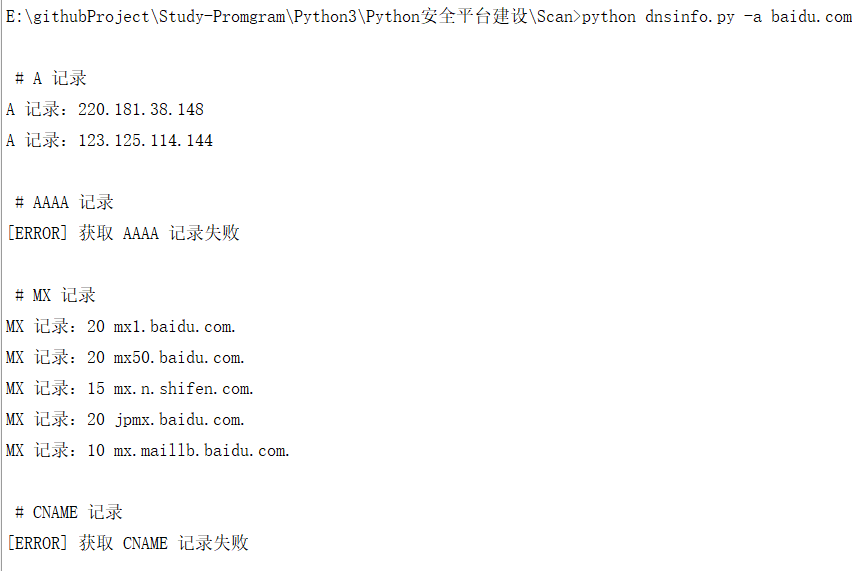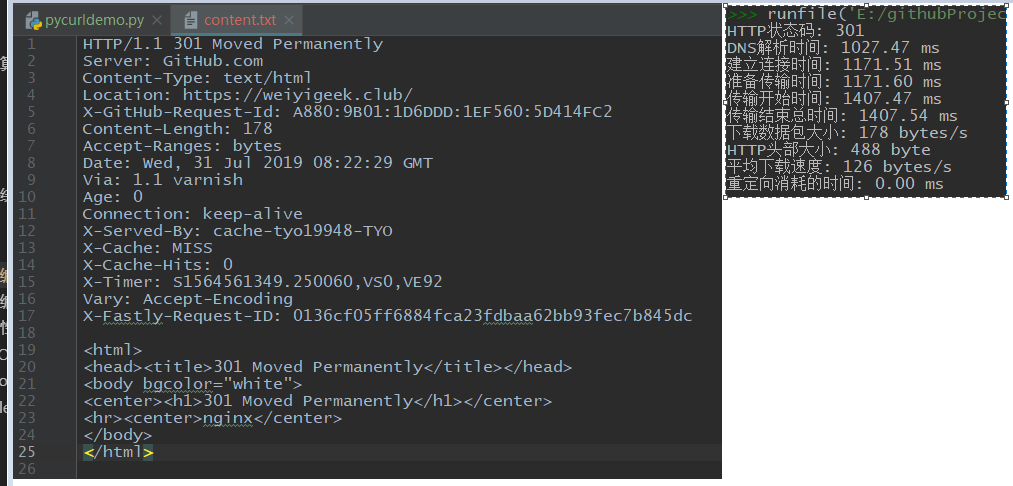Black hat programming application of Python1
[ TOC]
0 x00 Foreword####
In security workers or penetration testing, we often need to build our own wheels to write automated scripts, so Python scripts can help us write response scanners and scripts faster;
Expansion pack:
0 x01 IP address processing module####
Description: When scanning many businesses, we may need to enter an IP segment to scan it. In writing Python scripts, it is inevitable to calculate the IP address, including network segment/netmask/broadcast address/subnet number/IP type and many more;
Therefore, Python provides us with a powerful third-party module IPy, install the module and execute pip install IPy;
(1) Basic processing of IP address/network segment:
# /usr/bin/env python
from IPy import IP
#1. Distinguish between IPv4 and IPv6 and IP type
ipv4=IP('192.168.1.0/24').version()
ipv6=IP('::1').version()
#4 Stands for IPv4 6 stands for IPv6
print(ipv4," ",ipv6) # 46
iptype = ip.iptype() #'PRIVATE'Represents a private address
IP('132.54.56.25').iptype() #'PUBLIC'Represents a public address
print(IP('::1').iptype()) #LOOPBACK
print(IP('2001:0658:022a:cafe:0200::1').iptype()) #ALLOCATED RIPE NCC
#2. Network segment IP number and IP address list
ip=IP('192.168.10.0/24')len(ip) #Also the number of network subnets
print(ip.len()) #Enter the number of IPs in the network segment 256for x in ip: #Address list
print(x)print(str(ip[2]))
# Print result
# 192.168.10.0
# ....
# 192.168.10.255
#3. IP reverse name resolution
ip=IP('192.168.1.8')
revname = ip.reverseNames() #['8.1.168.192.in-addr.arpa.']
#4. IP conversion
IP("192.168.1.1").int() #3232235777 IP address conversion shaping
IP("192.168.1.1").strHex() #'0xc0a80101' #IP address to hexadecimal
IP("192.168.1.1").strBin() #'11000000101010000000000100000001' #To binary
print(IP(0xc0a80101)) #Convert hexadecimal to IP 192.168.1.1|IP('192.168.1.1')print(IP(3232235777)) #Convert decimal to IP192.168.1.1
#5. Network address subnet mask generation network segment format
IP('192.168.1.0').make_net('255.255.255.0') #IP('192.168.1.0/24')IP('192.168.1.0/255.255.0.0',make_net=True) #IP('192.168.0.0/16')IP('10.10.0.0/255.0.0.0',make_net=True) #IP('10.0.0.0/8')IP('10.10.0.0-10.10.255.255',make_net=True) #IP('10.10.0.0/16')
#6. Convert to IP and subnet mask through the network
IP('10.0.0.0/8').net() #IP('10.0.0.0')IP('10.0.0.0/8').broadcast() #IP('10.255.255.255')Get the subnet mask according to the network segment
# Specify different wantprefixlen parameter values through the StrNormal method to customize the network segments of different output types
# wantprefixlen value
0: No return, such as 192.168.1.01: prefix format a.b.c.0/24|2001:658:22a:cafe::/64 #Default format
2 :Decimal netmask format a.b.c.d/255.255.255.03: lastIP format a.b.c.0-a.b.c.2552001:658:22a:cafe::-2001:658:22a:cafe:ffff:ffff:ffff:ffff
# Sample demonstration:
IP('192.168.1.0/30').strNormal(0) #'192.168.1.0'Here you need to know the knowledge points of the subnet mask
IP('192.168.1.4/30').strNormal(0) #'192.168.1.4'2^ (32-30=2)=4 IP as a group
IP('192.168.1.0/30').strNormal(1) #'192.168.1.0/30'IP('192.168.1.0/30').strNormal() #'192.168.1.0/30'IP('192.168.1.0/30').strNormal(2) #'192.168.1.0/255.255.255.252'IP('192.168.1.0/30').strNormal(3) #'192.168.1.0-192.168.1.3' #Convert the number of hosts according to the subnet mask
(2) Multi-network calculation comparison:
Compare whether the two network segments contain overlaps, etc., IPy supports the comparison of numerical data, which can help IP objects to compare
#! /usr/bin/env python
# Example 1.Determine the interval of the network segment
IP("192.168.0.0/16")<IP("192.168.1.0/24") #True
IP("192.168.0.0/16")>IP("192.168.1.0/24") #False
# Determine whether the IP address or network segment is included in another network segment:
IP("192.168.0.0/16")inIP("192.168.1.0/24") #False
IP("192.168.1.0/32")inIP("192.168.1.0/24") #True
# Determine whether two network segments overlap,Using the overlaps method provided by IP
IP("192.168.1.0/32").overlaps("192.168.1.0/24") #1 contains
IP("192.168.2.5").overlaps("192.168.1.0/24") #0 does not contain
- actual case:*
[+ IPy module use case view](https://github.com/WeiyiGeek/Study-Promgram/blob/master/Python3/Python%E5%AE%89%E5%85%A8%E5%B9%B3%E5%8F %B0%E5%BB%BA%E8%AE%BE/Scan/ipinfo.py)
Useage:> ipinfo.py -t/-m 192.168.1.1-t Specify the IP type address for mutual conversion binary IP/Integer IP/Hexadecimal
- m Specify IP address or IP segment to view information
IP format 1: 192.168.1.1
IP format 2: 192.168.1.0/24
IP format 3: 192.168.1.1-192.168.1.254
0 x02 DNS processing module####
Description: dbspython in Python implements a DNS toolkit, supports all record types, is used to query/transmit and dynamically update ZONE information, and supports all record types;
Module installation: pip install dnspython
1. Detailed Method
dns provides a DNS resolution class-resolver, which uses its query method to implement query functions. The query method is defined as follows:
import dns.resolver
def query(qname, rdtype=dns.rdatatype.A, rdclass=dns.rdataclass.IN,
tcp=False, source=None, raise_on_no_answer=True,
source_port=0, lifetime=None):
The rdclass parameter is used to specify the network type, the optional values are IN, CH and HS, where IN is the default;
The tcp parameter indicates whether to enable the TCP protocol;
The rdtype parameter is used to specify the RR resource type:
- A record: Convert host name to IP address
- MX record: mail exchange record, which defines the domain name of the mail server
- CNAME record: Specify alias records to realize the mapping between domain names
- NS record: The domain name server and authorized subdomain name of the marked zone
- PTR record: reverse analysis is the opposite of A record, which converts IP address to host name
- SOA record: SOA marks the definition of a starting authorization zone
Sample demonstration:
# Example 1.A record passes response.answer method to get query response information
for i in dns.resolver.query('www.qq.com.cn','A').response.answer:for j in i.items:print("A record:%s"% j.address) #A record:61.129.226.218for i in dns.resolver.query('qq.com','A').response.answer:for j in i.items:print("A record:%s"% j.address)
# A record: 59.37.96.63
# A record: 58.60.9.21
# A record: 180.163.26.39
# Example 2.MX record
for i in dns.resolver.query('qq.com','MX'):print("MX preference = %s , mail exchanger = %s"%(i.preference,i.exchange))
# Traverse out preferences and mail exchange servers
# MX preference =20, mail exchanger = mx2.qq.com.
# MX preference =30, mail exchanger = mx1.qq.com.
# MX preference =10, mail exchanger = mx3.qq.com.
# Example 3.NS record (enter the root domain name)
for i in dns.resolver.query('qq.com','NS').response.answer:for j in i.items:print("NS record:%s"%j)
# Results of the
NS record: ns2.qq.com.
NS record: ns1.qq.com.
NS record: ns4.qq.com.
NS record: ns3.qq.com.
# Example 4.CNAME record
for i in dns.resolver.query('weiyigeek.github.io','CNAME').response.answer:for j in i.items:print("CNAME record:%s"%j) #CNAME record:www.weiyigeek.github.io.
# Example 5.SOA authorization area definition
for i in dns.resolver.query('baidu.com','SOA'):print(i)
# dns.baidu.com. sa.baidu.com.201214121830030025920007200
actual case:
[+ View on Github](https://github.com/WeiyiGeek/Study-Promgram/blob/master/Python3/Python%E5%AE%89%E5%85%A8%E5%B9%B3%E5%8F%B0% E5%BB%BA%E8%AE%BE/Scan/dnsinfo.py)

WeiyiGeek.dnsinfo information view
0 x01 web detection module####
pycurl module#####
Description: pycurl is a libcurl Python implementation written in C language, with powerful functions and support for multiple communication protocols. The Python package similar to the Curl command function under Linux is simple and easy to use;
Module installation:
# installation
pip install pycurl #May report an error Please specify--curl-dir=/path/to/built/libcurl(Re-execute after installation)
# If error access: https://www.lfd.uci.edu/~gohlke/pythonlibs/#pycurl download pycurl-7.43.0.3-cp37-cp37m-win32.whl(According to your Python version)
Processing c:\users\weiyigeek\downloads\pycurl-7.43.0.3-cp37-cp37m-win32.whl
Installing collected packages: pycurl
Successfully installed pycurl-7.43.0.3
# View version
python -c "import pycurl;print(pycurl.version)"'PycURL/7.43.0.3 libcurl/7.64.1 OpenSSL/1.1.1c zlib/1.2.11 c-ares/1.15.0 libssh2/1.8.2'
The main function:
- Web service quality detection: HTTP status code/request delay/HTTP header information/download speed, etc.
- Detection service availability and service response speed
Common methods of modules:
pcurl = pycurl.Curl #Create object
pcurl.setopt(option,value) #curl_easy_setopt method, value will depend on option
pcurl.perform() #Realize the request submission of pycurl objects
pcurl.getinfo(option) #Get pycurl object request response information
pcurl.close()
Use the constant values provided by the libcurl package to achieve the purpose of detecting the quality of Web services:
# setopt
pc.setopt(pycurl.URL, URL) #Define the requested URL
pc.setopt(pycurl.USERAGENT,"Mozilla/5.0 (Windows NT 10.0; Win64; x64; rv:68.0) Gecko/20100101 Firefox/68.0") #Set http request header USERAGENT
pc.setopt(pycurl.CONNECTTIMEOUT,5) #Connection waiting time, 0 means no waiting
pc.setopt(pycurl.TIMEOUT,5) #Request timeout
pc.setopt(pycurl.MAXREDIRS,1) #Maximum number of redirects
pc.setopt(pycurl.NOPROGRESS,1) #Whether to block the download progress bar if it is not 0, block it
pc.setopt(pycurl.MAXREDIRS,1) #Specify the maximum number of HTTP redirects as 1
pc.setopt(pycurl.DNS_CACHE_TIMEOUT,30) #Error reporting DNS information is 30s
pc.setopt(pycurl.FORBID_REUSE,1) #Disconnect after completing the interaction without reusing
pc.setopt(pycurl.FERSH_CONNECT,1) #Force a new connection to replace the connection in the cache
pc.setopt(pycurl.HEADERFUNCTION, getheader) #Direct the returned HTTP HEADER to the callback environment getheader
pc.setopt(pycurl.WRITEFUNCTION, getbody) #Direct the returned HTTP BOBY to the callback environment getboby
pc.setopt(pycurl.WRITEHEADER, index) #Direct the return HTTP HEADER to the indexfile file object
pc.setopt(pycurl.WRITEDATA, index) #Direct the returned HTML content to the indexfile file object
# getinfo
print("HTTP status code: %s"%(pc.getinfo(pc.HTTP_CODE)))print("DNS resolution time: %.2f ms"%(pc.getinfo(pc.NAMELOOKUP_TIME)*1000))print("Connection time: %.2f ms"%(pc.getinfo(pc.CONNECT_TIME)*1000))print("Ready to transfer time: %.2f ms"%(pc.getinfo(pc.PRETRANSFER_TIME)*1000))print("Transmission start time: %.2f ms"%(pc.getinfo(pc.STARTTRANSFER_TIME)*1000))print("Total transmission end time: %.2f ms"%(pc.getinfo(pc.TOTAL_TIME)*1000))print("Redirection time: %.2f ms"%(pc.getinfo(pc.REDIRECT_TIME)*1000))print("Download packet size: %d bytes/s"%(pc.getinfo(pc.SIZE_DOWNLOAD)))print("Upload packet size: %d bytes/s"%(pc.getinfo(pc.SIZE_UPLOAD)))print("Average download speed: %d bytes/s"%(pc.getinfo(pc.SPEED_DOWNLOAD)))print("Average upload speed: %d bytes/s"%(pc.getinfo(pc.SPEED_UPLAOD)))print("HTTP header size: %d byte"%(pc.getinfo(pc.HEADER_SIZE)))
actual case:
#! /usr/bin/env python
# - *- coding: utf-8-*-
# @ File : pycurldemo.py
# @ CreateTime :2019/7/3115:23
# @ Author : WeiyiGeek
# @ Function :Realize the detection of web service quality and web page screenshots
# @ Software: PyCharm
import sys, time
import pycurl
URL="http://www.weiyigeek.github.io"
def request():"""
Build request
: return:"""
pc = pycurl.Curl() #Construct a Curl object
pc.setopt(pycurl.URL, URL) #Define the requested URL
pc.setopt(pycurl.CONNECTTIMEOUT,5) #Connection waiting time, 0 means no waiting
pc.setopt(pycurl.TIMEOUT,5) #Request timeout
pc.setopt(pycurl.NOPROGRESS,1) #The download progress bar is similar to curl
pc.setopt(pycurl.FORBID_REUSE,1) #Disconnect after completing the interaction without reusing
pc.setopt(pycurl.MAXREDIRS,1) #Specify the maximum number of HTTP redirects as 1
pc.setopt(pycurl.DNS_CACHE_TIMEOUT,30) #Error reporting DNS information is 30s
pc.setopt(pycurl.USERAGENT,"Mozilla/5.0 (Windows NT 10.0; Win64; x64; rv:68.0) Gecko/20100101 Firefox/68.0")
# Create a file object to'wb'Way to open, store the returned http header information and page content;withopen('content.txt','wb')as index:
pc.setopt(pycurl.WRITEHEADER, index) #Direct the return HTTP HEADER to the indexfile file object
pc.setopt(pycurl.WRITEDATA, index) #Direct the returned HTML content to the indexfile file object
try:
pc.perform() #Submit request
except Exception as e:print("connect Error:"+str(e))
sys.exit()return pc
def reponse(pc):"""
Return request response data analysis
: param pc::return:"""
print("HTTP status code: %s"%(pc.getinfo(pc.HTTP_CODE)))print("DNS resolution time: %.2f ms"%(pc.getinfo(pc.NAMELOOKUP_TIME)*1000))print("Connection time: %.2f ms"%(pc.getinfo(pc.CONNECT_TIME)*1000))print("Ready to transfer time: %.2f ms"%(pc.getinfo(pc.PRETRANSFER_TIME)*1000))print("Transmission start time: %.2f ms"%(pc.getinfo(pc.STARTTRANSFER_TIME)*1000))print("Total transmission end time: %.2f ms"%(pc.getinfo(pc.TOTAL_TIME)*1000))print("Download packet size: %d bytes/s"%(pc.getinfo(pc.SIZE_DOWNLOAD)))print("HTTP header size: %d byte"%(pc.getinfo(pc.HEADER_SIZE)))print("Average download speed: %d bytes/s"%(pc.getinfo(pc.SPEED_DOWNLOAD)))print("Redirection time: %.2f ms"%(pc.getinfo(pc.REDIRECT_TIME)*1000))
pc.close()
def main():"""
Request function call
Response function call
: return:"""
pcurl =request()reponse(pcurl)return0if __name__ =='__main__':main()

WeiyiGeek.pycurl module
Recommended Posts